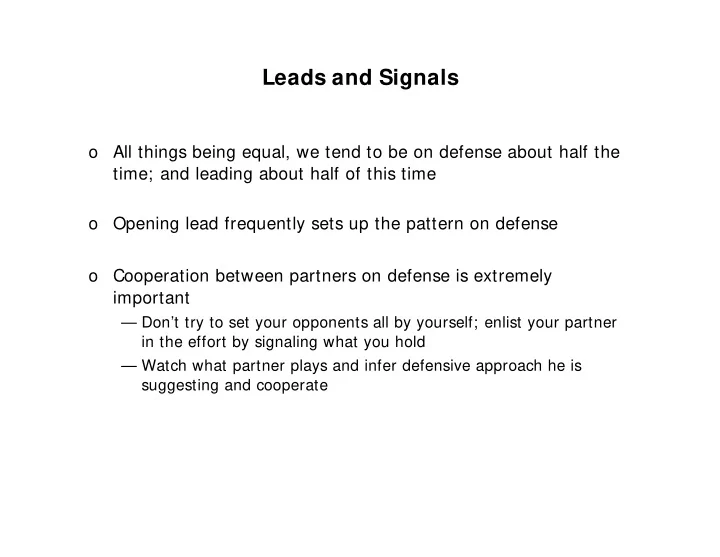

Leads and Signals o All things being equal, we tend to be on defense about half the time; and leading about half of this time o Opening lead frequently sets up the pattern on defense o Cooperation between partners on defense is extremely important — Don’t try to set your opponents all by yourself; enlist your partner in the effort by signaling what you hold — Watch what partner plays and infer defensive approach he is suggesting and cooperate
Leading o The key to selecting an opening lead is to listen to the auction and infer what that says about everyone’s hand — Has your partner bid --> Possible indication of suit to lead — Have the opponents bid easily and swiftly to game with no interference and you have near an opening hand --> your partner has nothing and the defense is “up to you” — Have the opponents struggled and found a secondary place to play -- > They may not have enough trump and a trump lead might be appropriate — Do you have “Connected Honors (I.e., an AK)” --> then you might want to lead the honor to see what dummy has and then make your “real” lead — Do you have a series (I.e., QJT9) -- If you can lead enough times, you can eventually drive out their honors
Example hand
Example hand - Solved
Types of Leads o Aggressive/Active -- Use if opponents have side source of tricks o Tapping -- Use when you have length in trump suit; try to make opponents use their trump by ruffing your long suit o High roller leads -- Very aggressive and gambling leads; usually want to use only in team games where payoff for gamble is large; can backfire in pairs games o NT contracts -- usually call for aggressive leads so tricks don’t get away (timing can be very important at NT) o Passive leads -- When it is clear that opponents will really have to work to make contract (make them earn every trick) o Trump leads -- Can be both passive and aggressive (try not to finesse partner though) o Pattern leads and leads from “Nothing” (fourth best, third and fifth, MUD, BOSTON, etc.)
Signals o Partner has made an opening lead -- How do I tell him what to do next? o Opponent has played a suit and I can’t follow suit -- How do I tell partner what to play when he gets the lead? o I know partner can ruff a card I play -- How do I tell him how to get back to me for a second ruff? o How to tell partner how many cards I have in a suit o All these are examples of “Signaling” (I.e, telling partner what to play next) — Typical signaling methods: Standard, Upside down, Lavinthal (discards only), Odd/Even (discards only) o Also need to discuss “primary” signal to partner’s lead (attitude, count, or suit preference)
Signals
Signals
Leads and Signals o Suggest you and partner take time to clearly note exactly how you want to play defense and mark on convention card (see below) Lea ds a nd Sign a ls Response t o pa rt n er’s opening le a d: a) Alw ays play upside dow n attitude (high card discourages suit and low encourages) unless: b) I f its obvious that continuation of suit w ill be taken by them , then change to suit preference signal (high card – higher non trum p suit, low card – low er non trum p suit). M y ope ning lea d: a) Per the convention card for honors and/ or series (i.e., top of series or internal series) against suit and NT contracts. b) I f not honor or series lead (per above), start of norm al count sequence (right side up – high-low indicates even num ber of cards) w ith 3 rd or 5 th best card against suit contract. c) I f not honor or series lead (per above), 4 th best against NT. Aft e r openin g lea d: a) I f partner breaks new suit, then give upside dow n attitude signal. b) I f opponents break new suit, then start norm al count sequence. c) I f I break new suit, then start norm al count sequence w ith 3 rd or 5 th best (unless honor/ series). Count : Use norm al count at all tim es. High-Low m eans even num ber and Low -High m eans odd num ber in suit. How ever, attitude is prim ary signal to leads. "Te n D enie s": The lead of a ten im plicitly denies holding any cards higher than that. The lead of a 9 im plies a higher card. BOSTON Lea ds : During the play, leading a low card w ill im ply that I have "som ething" in a suit. Leading a high card w ill im ply that I have "nothing". D isca rds: Alw ays upside dow n suit preference (e.g., low card m eans I like suit and high card m eans I don’t like suit). Trum p Suit Preference ( TSP) signals: a) I f I am initially on lead and don't lead a trum p, there are tw o suits rem aining (i.e., non-led and non-trum p). These are the tw o suits that the TSP w ill apply to. (Note, you w ill have given m e an attitude signal on m y lead.) I f I do lead a trum p initially, there w ill be som e am biguity about the TSP signals.
Recommend
More recommend